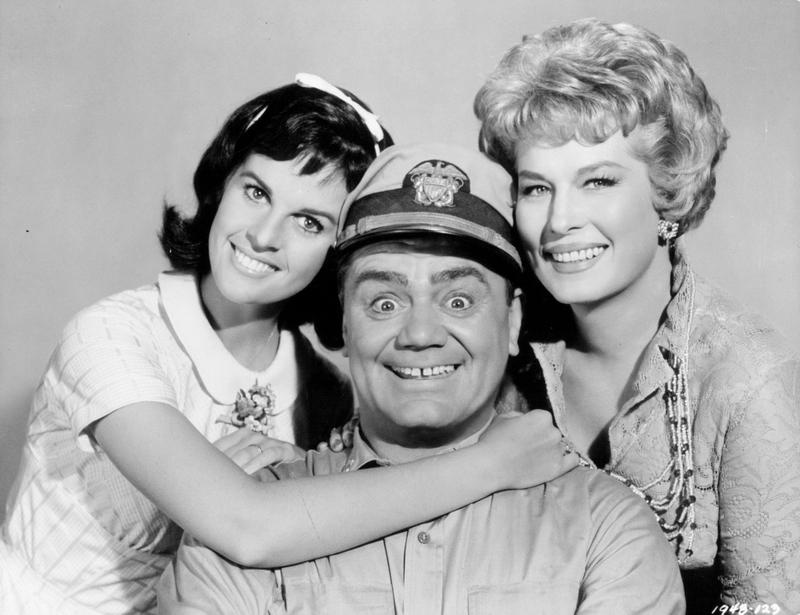“McHale’s Navy” …. They Don’t Make Them Like This Anymore!
By | September 5, 2018

McHale’s Navy is one of those television sitcoms that was popular in the '60s in the U.S. While the show was filmed and aired in the '60s, it was set in the '40s during World War II. It was a lighthearted distraction for viewers amid the growing cultural unrest at the time.
Lieutenant Commander Quinton McHale was portrayed by the Oscar Award and Academy Awarding winning, Ernest Borgnine.
McHale was the Commanding Officer of the fictional U.S. Navy PT-73. He and his men were stationed in the Pacific on an island they refer to as McHale’s Island. It is directly across from another South Pacific island called Taratupa, which is where the main Naval Base is located.
Joe Flynn portrayed Captain Binghampton on the hit television sitcom, McHale’s Navy.
As the story went, McHale and his men were a group of misfits that used any advantage they could to get one over on Captain Binghampton. If you remember watching McHale’s Navy, you will remember that although they were technically on the same side, McHale and his men were always at odds with their Captain. The Captain’s name was Wallace B. Binghampton but McHale and his men often referred to him as, “Wally” or “Captain Leadbottom.” Binghampton spent most of his waking hours trying to figure out a way to expose McHale and his men for the many antics they pulled. He dreamt of having the whole bunch court-martialed.

“Knock it off, you eight balls!”
The men who served under McHale, much like McHale himself, were always scheming. Just about the only thing military about them was their uniforms. Most of their antics involved pranks, money, gambling and womanizing. McHale, as Commanding Officer, often tried to put his foot down on some of the stunts his men pulled. He was known to call them goofballs and/or eight balls. More often than not, however, he usually followed suit and got involved in the craziness.

McHale’s Navy was entirely filmed and aired in black and white.
McHale and his men had befriended the native tribes on the island who would help them with everything from pranks to maintaining their lifestyle. Another unlikely ally was Fuji, who was a Japanese Sailor and a P.O.W. and had defected to join in with McHale’s efforts. He was as incorrigible as the rest of the men. McHale often found himself hiding Fuji when Captain Binghampton would appear unannounced.
While the men had nicknames for the Captain, he also had some of his own for them. Captain Binghampton often called McHale and his men pirates, cutthroats, bandits, yo-yos, brigands and highwaymen.
Because of the close relationship McHale and his crew had with the natives, they often helped out in times of conflict, giving McHale an advantage. With all of the shenanigans the men were known for, which infuriated Captain Binghampton, they had the favor of the Navy Admirals because they always accomplished their mission.

The ship they called the PT-73 was once owned by and sold to Universal Studios by Howard Hughes. It was an actual torpedo boat but was really a PT-658.
The unorthodox crew of sailors were often getting into some sort of mischief. They often used the Navy-owned PT-73 to go on unauthorized excursions. It was not uncommon for McHale and the men to take the boat out for a deep-sea fishing trip or to go sightseeing or water skiing.

McHale and his men lived a carefree and fun-filled life on their little island. They were often shown out of uniform in “loud” Hawaiian shirts and leis. It was fun to watch what trouble they would stir up from week to week.
Yoshio Yoda portrayed Fuji on McHale’s Navy.
The one exception to the misfit rule may have been Ensign Parker, was portrayed by funny man, Tim Conway. Parker was to have been a replacement for another Ensign who was named but never seen on the show. After his arrival, he found himself stranded on the island. He was “more military” than the rest of the bunch but was their ally just the same.

Ensign Parker, portrayed by funnyman, Tim Conway, was McHale’s, so-called, right-hand man and somewhat of a bumbler. Lieutenant Elroy Carpenter, also referred to as, “Carpy,” was portrayed by Bob Hastings. He was a brown-nosing “yes-man” who often fell short of his duties.
Ernest Borgnine actually served in the Navy during World War II.
McHale’s Navy was a welcome distraction from the real war going on in the '60s. It was quite entertaining but highly unrealistic. The cast was phenomenal, which is most likely why the show did so well. They just don’t make shows like this anymore!
McHale’s Navy Cast:
- Ernest Borgnine as Lieutenant Commander Quinton McHale
- Tim Conway as Ensign Charles Parker
- Joe Flynn as Captain Wallace B. Binghamton ("Old Leadbottom")
- Bob Hastings as Lieutenant Elroy Carpenter
- Gary Vinson as George "Christy" Christopher, quartermaster
- Bobby Wright as Willy Moss, radioman
- Carl Ballantine as Lester Gruber, torpedoman's mate
- Billy Sands as Harrison "Tinker" Bell, engineman and motor machinist mate
- Edson Stroll as Virgil Edwards, gunner's mate
- Gavin MacLeod as Joseph "Happy" Haines, seaman (1962–1964)
- Yoshio Yoda as Fuji Kobiaji, cook, Seaman 3rd class, Japanese POW; in season 2, episode 13 ("A Letter for Fuji"), he is given the name Fujiwara Takeo.
